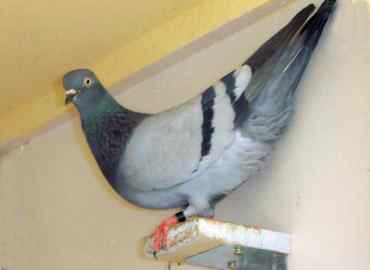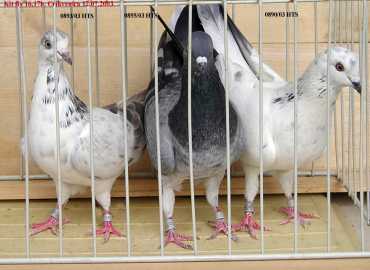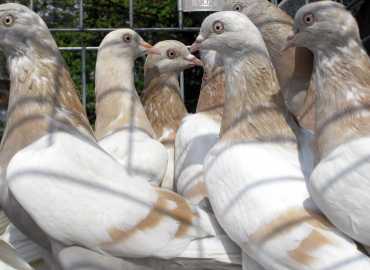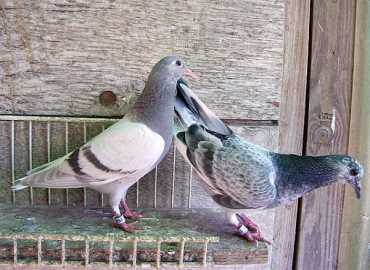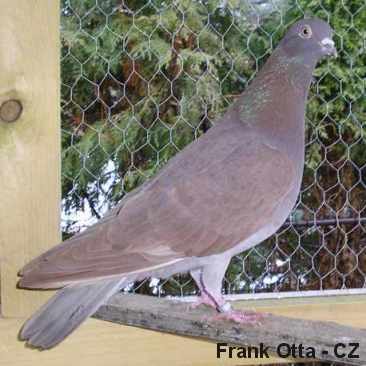
A: The tippler originated in England and was bred from high and long flying pigeons that were brought home by English sailors and soldiers from former British colonies (India, Pakistan,...) and from coutries that England was engaged in trade with. This happened nearly 200 years ago. During the course of time, little by little, the tippler developed to the pigeon we know today. The tippler veins contain the blood of Asian highfliers, English rollers, European mainland tumblers, and French Cumulet. I have also heard that homing pigeon genes might be present in the tippler genetic make up as well.
Q: How did the tippler sport come to existence?
A: Soon after the initial imports and some blood crossing, the flying tippler sport became popular in England. As you may know, the Englishmen are very competitive people and like to close bets. The low cost to keep tipplers opened the door to the sport for working class breeders around the towns of Macclesfield and Sheffield in the first half of the 18th century and the first competitons were flown in the second half of the same century. The first official world record 11:08 hours was set by Mr. J. Ball in Macclesfield in 1876
Q: How far can a tippler fly?
A: Tipplers do not fly distances, they are endurance fliers that fly in relatively high circles in kits of few to several birds over their breeder's loft. The kit longest on wing wins the contest as opposed to the homer competition where the bird shortest on wing wins.
The current world record, 22:05 hours, is held by Mr. Harry Shannon of Ireland. If I estimate the average speed of a tippler at 50 km/h and multiply this by 22:05 hours, I arive to a figure exceeding the 1.100 km distance that a tippler can fly non stop in one day. Now, do you know a homing pigeon who can do this?
My training kits consist of just a few birds. My largest kit is the kit of youngsters at the begining of the training season - it may consist of about a dozen of birds from which I later select best five to seven that I continue working with. From this bunch I further select three in the best condition on a particular day for a particular competition fly.
Q: What a tippler should look like?
A: There is no standard that prescribes the looks of the competition tippler and the quality of this breed is set, in many eyes, by its ability to endure. That is the most valuable thing in the competition tippler. However, there is the show tippler standard, but this bird cannot match the flying abilities of the competiton tippler (15+) and one must decide what is his breeding objective: flying competitons or attending shows? So if you look at the different competiton tippler lines, you will see birds with rounded heads or heads a bit flat on the top, a bird with a slim built or a bird with a more robust stance, shorter or longer legs, pearl or bull eyes (in my loft, there are couple 15+ birds whose one eye is pearl and the other is bull). The number of tail feathers may differ too but the breeders prefer tipplers that have 10 primaries and 12 tail feathers. I have heard that tipplers having no.8 primary longer than no.9 can fly better but cannot confitm this theory.
 Tipplers can be found in colors and patterns ranging from self colored, through badges, to grizzles and mottles. In my oppinion, the color of a tippler matters the least - just take a look at the pictures at this website and see for yourself.
Tipplers can be found in colors and patterns ranging from self colored, through badges, to grizzles and mottles. In my oppinion, the color of a tippler matters the least - just take a look at the pictures at this website and see for yourself.Q: What tippler line should I get?
A: Champions of the best line you know and can afford ! They are the birds that originated in the lofts of the gentlemen like Harry Shannon, Jack Boden, Gordon Hughes, Paul Bowden, George Pilot, Eric Anslow,... (I have mentioned just a few well-known names here and there are many other lofts around the world that house birds of similar quality). You do not really have to go directly to the lofts of the above mentioned fliers - some of them no longer live - yet their lines are still kept and available in quite a few lofts around Europe. Just make sure you are getting a line with proven record from people who fly competitons.
Q: What is this "line"?
A: Let's say there is a Mr. Brown who purchased couple tippler pairs of excellent quality. He starts breeding from them his own family of birds and during this inline breeding he develops a line that suits his taste (looks) and meets his requirements (performance). All his birds are going to look like a pea in the pot. Now let's say, after 20 generations of close breeding, this Mr. Brown sets the national or world record and people start being interested in purchasing his birds. When they get Mr. Brown's birds in their lofts, they relish them and when the birds fly good times for them, they speak highly of them. They tell everybody: "I have (the family of) Browns" and, in our neck of the woods, we call such family a "line".
You can see "pure" Hughes, Shannons, Bodens, Westicotts, Currys, Kocholls, Van der Werfs, and their crosses in my loft.
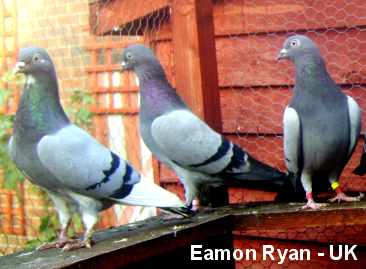 Why did I put the word "pure" in quotation marks? The best answer was given to us by Harry Shannon, the current world record holder, who said: "People say they have Shannons. I say they do not. Once a bird leaves my loft, it is no longer a Shannon. The bird has now different housing, different food, different training, different master. In short, quite different conditions."
Why did I put the word "pure" in quotation marks? The best answer was given to us by Harry Shannon, the current world record holder, who said: "People say they have Shannons. I say they do not. Once a bird leaves my loft, it is no longer a Shannon. The bird has now different housing, different food, different training, different master. In short, quite different conditions."
Deep truth. Even though there are birds in my loft whose genes are identical to the genes of former or current world champions, my birds do not fly 20+. Those are the "quite different conditions" that Harry Shannon is talking about. Many people can learn to play the violin but very, very few of them became a virtuoso...
Q: What do I need to keep tipplers?
A: Tippler is a very modest breed. A smaller, dry loft shielded from the wind will do. During the training period, I feed two or three tea spoons of barley (and a pinch of rap seed) once a day and give water 30 minutes later. By this I do not want to say that a tippler would not eat more - any pigeon can eat more than can digest in a day - but if you feed your tipplers too much, they get heavy and won't fly well for you. The competition tippler should not weigh more than 27 dkg. The same with water: "You do not want your tipplers coming down looking for water during the competition fly, you want your kit to stay on the wing as long as possible. Do you see any water over here?" (Zlatko Klacar on a hot summer day to me while visiting him).
The greatest demand put on a breeder is his time. A whole lot of time to train his birds, and the regularity in training and feeding. One cannot take a two week vacation, have some one else to feed his birds and hope he can compete when he returns. My experience...
Q: How do I train my tipplers?
A: When you train your kit, just make sure, your birds are not on the heavy side, so stay avay from caloric food. I train my kit every other or third day - this gives me the chance to rotate more kits in training and later I can chose from them my best three (or five - an odd number of birds in a kit flies better. Do not ask me why, I do not know the answer, but it is true).
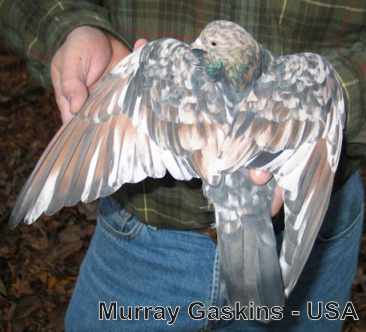 If your kit on diet can stay on wing 6 - 7 hours, it is just perfect. I do not push my birds. Try to understand that they are living creatures just like us people. Sometimes we feel like working sometimes we don't. The same with the birds. On different occations, I have recorded training times as low as 5 hours and as high as nearly 12 hours with the SAME kit.
If your kit on diet can stay on wing 6 - 7 hours, it is just perfect. I do not push my birds. Try to understand that they are living creatures just like us people. Sometimes we feel like working sometimes we don't. The same with the birds. On different occations, I have recorded training times as low as 5 hours and as high as nearly 12 hours with the SAME kit.
I consider 6-7 hours to be an optimum training time. At this time I try to drop my birds using my droppers. The tippler-dropper relationship is basically a Pavlov's reflex imprinted on tipplers. The tipplers should always be let to the droppers compartment to feed together and when the tiper kit sees from the air the feeding droppers on the roof top, the kit will come down (sooner or later:-)If the tipplers kept a bit on the hungry side, they will respond to the droppers better as a rule. I have seen my kit put brakes in the air and be down and inside in just 3 minutes, I have seen my kit overfly way into darkness... Sometimes it's harder to get a good kit down than to let it fly - a good tipler just wants to fly and when you have 5 good tiplers on a kit, I noticed they seem to instigate each other by taking the lead to fly longer and into dark. I use this dark flying ability of theirs to train them to drop into light under which the droppers are feeding. It is thus very usefull to train your young tipplers from the very beginning not to be affraid of dark by feeding them together with the droppers under light outside on the loft top after dark even before the young birds can fly. If you want to fly 18+ in this country, you must figure the dropping time will be in dark, there is no other way around. When your kit tipplers responds well to the droppers and can (is not afraid to) drop in dark, the birds are ready for their big competition day.
Q: How do I achieve the best time possible?
A: You should get you birds in condition before the competition. As I have already mentioned, the kit must be trained first. You cannot rely on purchasing good birds, settling their youngsters, let them hang around on the roof top than wave a flag on them on a competition day morning and expect them to fly 15+ . By regular training you are building the birds' muscles and to compete, your birds must have enough carbohydrates and proteins to achieve the best time possible. The birds also must be rested and looking forward to the opportunity to spend all their energy. I accomplish that goal with doing the following:

